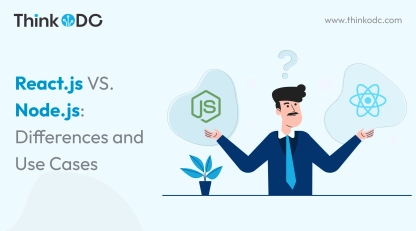Welcome to the exciting world of Node.js development! If you're reading this, you're likely already familiar with Node.js and its importance in modern web development. But for those who aren't, Node.js is an open-source, cross-platform JavaScript runtime that allows developers to build scalable and high-performance applications.
Since its introduction in 2009, Node.js has undergone significant growth and continuous development to meet the ever-changing demands of the tech industry. With over 6.3 million websites in the US utilizing Node.js, it is evident that it has become a widely popular tool. But what's the next big thing in Node.js development?

In this blog, we'll explore some of the emerging trends in Node.js development, such as serverless computing, microservices architecture, and real-time web applications. We'll also discuss the key benefits of Node.js when you adopt these trends, as well as some challenges you might face along the way.
So, let's get started!
Current State of Node.js Development
Node.js has come a long way since its early days. It has established itself as a reliable and efficient tool for building modern web applications. Currently, Node.js is known for its non-blocking I/O model, event-driven architecture, and speedy performance. It's like the Flash of web development - fast, reliable, and always ready to save the day.
Read More: Node.js Performance: What Makes It So Fast?
Thanks to its extensive library of packages and modules, Node.js developers have access to a wide range of tools that can help them build complex applications. From web frameworks like Express and Koa to utility libraries like Lodash and Moment, there are many reasons to choose node.js. It's like a giant toy chest for developers - every tool they could ever want is right there at their fingertips.
However, like any technology, Node.js has its limitations and challenges. One of the main challenges faced by Node.js developers is the issue of scaling. Node.js can handle a high volume of requests, but when it comes to scaling horizontally, things can get a bit tricky. It's like trying to fit a square into a round hole - it's possible, but it's not always easy.
Despite these challenges, Node.js development continues to thrive. It has become a popular choice for building real-time applications, such as chat applications and online games. Its lightweight nature makes it ideal for building microservices, and its non-blocking I/O model makes it perfect for handling I/O-bound tasks.
Emerging Trends in Node.js Development
The tech industry moves fast, and Node.js development is no exception. As developers look for new and exciting ways to build applications, several emerging trends have taken center stage.

Here are a few of the top Node.Js development trends:
Serverless computing
No, this doesn't mean that the servers have suddenly disappeared - it just means that developers no longer have to worry about managing the servers themselves. With serverless computing, developers can focus on writing code and leave the server management to the cloud provider.
It's like having a personal butler - you don't have to worry about cleaning up after yourself, they'll take care of it for you.
Microservices architecture
Microservices architecture is a way of designing applications as a collection of small, independently deployable services. It's like building a lego house - each piece fits together perfectly, but you can also take each piece apart and use it in a different way.
Microservices architecture allows developers to build scalable and flexible applications, and Node.js is a perfect fit for this type of architecture.
Real-time web applications
Real-time web applications are also an emerging trend in Node.js development. Real-time applications, such as chat applications and online games, require a high level of interactivity and responsiveness. Node.js is well-suited for building real-time applications, thanks to its non-blocking I/O model and event-driven architecture.
Containerization
Containerization is another trend that is gaining traction in Node.js development. Containers provide a lightweight and portable way of packaging applications and allow developers to easily deploy and manage their applications across different environments.
With the rise of container orchestration platforms like Kubernetes, containerization has become an increasingly popular choice for deploying Node.js applications.
Artificial Intelligence and Machine Learning
Artificial Intelligence and Machine Learning are also making their way into Node.js development. With the rise of AI-powered applications, developers are looking for ways to integrate machine learning algorithms into their Node.js applications.
It's like having a personal assistant - they learn your habits and preferences and anticipate your needs before you even ask.
Progressive Web Apps
Progressive Web Apps (PWAs) are gaining popularity as an alternative to native mobile apps. PWAs provide an app-like experience through a web browser, with features such as offline support and push notifications.
It's like having the best of both worlds - the convenience of a web app and the functionality of a native app.
Benefits of Adopting Emerging Trends in Node.js Development
Node.js development is constantly evolving, and adopting the latest trends can offer numerous benefits for developers and businesses alike.
Here are some of the benefits of adopting the emerging trends in Node.js development:
First and foremost, adopting emerging trends in Node.js development can lead to increased efficiency and productivity. For example, using serverless computing means developers can focus solely on writing code, without having to worry about server maintenance and management.
This can lead to faster development cycles and quicker time-to-market for applications. It's like having a personal assistant who takes care of all the tedious tasks, so you can focus on the fun stuff.
Adopting emerging trends in Node.js development can also lead to better scalability and flexibility. For instance, microservices architecture allows applications to be broken down into smaller, more manageable components, which can be independently deployed and scaled.
This means applications can easily handle increases in traffic and demand, without sacrificing performance. It's like having a transformer that can adapt to any situation - you can reconfigure it as needed, without missing a beat.
Another benefit of adopting emerging trends in Node.js development is improved user experience. Real-time web applications, for example, offer a high level of interactivity and responsiveness, which can greatly enhance the user experience.
Similarly, using AI and ML can enable applications to make more intelligent decisions, and provide personalized experiences for users. It's like having a butler who knows you so well, they can anticipate your every need before you even ask.
Conclusion
Node.js development is a constantly evolving landscape, with new trends and technologies emerging all the time. By staying on top of these trends and adopting them into their development workflows, developers can stay ahead of the curve and build better, more scalable, and more innovative applications.
Whether it's serverless computing, microservices architecture, real-time applications, containerization, or AI and ML, these emerging trends offer exciting new possibilities for businesses to enhance their offerings and stay competitive in the market.
By embracing these trends and hire Node.js developers, businesses can push the boundaries of what's possible in web development and create truly transformative applications that make a real difference in the world.




